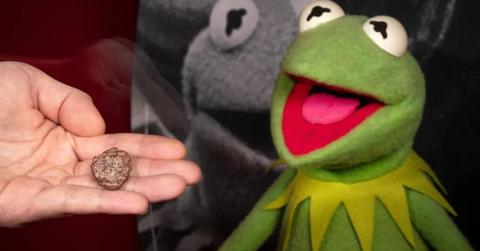Muppet Muse: Kermit the Frog Inspires Naming of Ancient Amphibian Ancestor Found in Smithsonian Collection

Researcher Calvin So holds the fossil skull of Kermitops, a new species of ancestral amphibian discovered in the museum’s collection.
The fossilized skull of an ancient amphibian ancestor found in the collection of the Smithsonian’s National Museum of Natural History has been named after Kermit the Frog.
A team of researchers led by Calvin So, a doctoral student at the George Washington University, described the 270 million-year-old fossil as a new species of proto-amphibian, and named it Kermitops gratus in honor of the Muppet created by Jim Henson in 1955.
“Using the name Kermit has significant implications for how we can bridge the science that is done by paleontologists in museums to the general public,” So said in a statement. “Because this animal is a distant relative of today’s amphibians, and Kermit is a modern-day amphibian icon, it was the perfect name for it.”
The fossilized skull measures just over an inch long, and features large, oval eye sockets. It was originally found by the paleontologist Nicholas Hotton III, who was a curator in the museum’s paleobiology department for nearly 40 years.
Hotton and his team excavated fossils from north central Texas, where rust-colored rock outcrops known as the Red Beds date back to the early Permian period more than 270 million years ago.
They collected so many fossils — including ancient reptiles, amphibians and sail-backed synapsids, the precursors to modern mammals — that they couldn't study them all in detail.
The skull fossil was collected in a rock layer known as the Clear Fork Formation in 1984, and it has been waiting for decades in the museum's fossil collection to be researched more closely.
Arjan Mann, So's mentor and co-author on the new study, was looking through Hotton's Texas fossils in 2021 when he saw the skull labeled as an early amphibian.
“One fossil immediately jumped out at me — this really well preserved, mostly prepared skull,” Mann said.
Together, So and Mann studied the skull, which had a mix of traits that were different from those seen in older tetrapods, the ancient ancestors of amphibians. The skull's proportions likely helped Kermitops eat grub-like insects, and it probably looked a bit like a stout salamander.
Although they initially identified the fossil as a temnospondyl, a group of amphibian relatives that lived for more than 200 million years from the Carboniferous to the Triassic periods, it had such unique features they decided it belonged to an entirely new genus, which they named Kermitops.
Never miss a story — sign up for the Front Page Detectives newsletter. Be on the scene the moment news breaks.
The species name gratus represents their gratitude to Hotton and his team for their discovery.
The study, published recently in the Zoological Journal of the Linnean Society, helps fill in a fragmentary family tree for frogs, salamanders and other amphibians.
“Kermitops offers us clues to bridge this huge fossil gap and start to see how frogs and salamanders developed these really specialized traits,” So said.
More answers may be found in similarly forgotten fossils that were long ago unearthed, waiting in museum collections to be studied.
“This is an active area of research that a lot more paleontologists need to dive back into,” Mann said. “Paleontology is always more than just dinosaurs, and there are lots of cool evolutionary stories and mysteries still waiting to be answered. We just need to keep looking.”
TMX contributed to this report.
Become a Front Page Detective
Sign up to receive breaking
Front Page Detectives
news and exclusive investigations.
